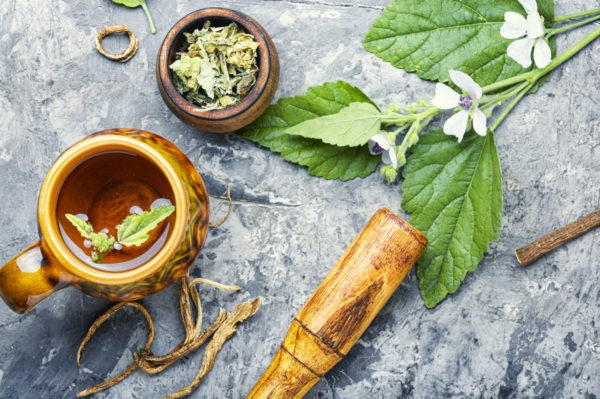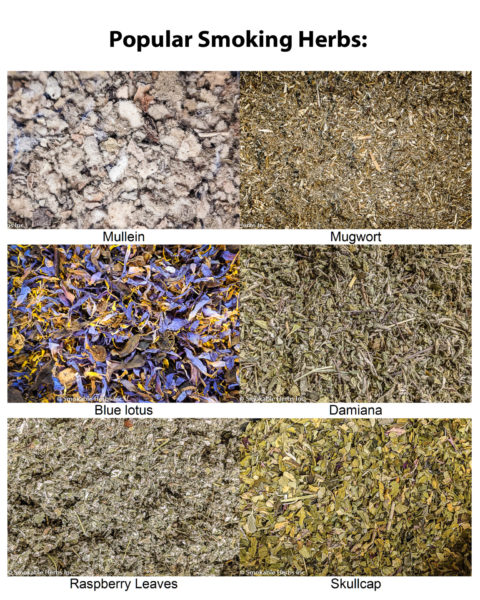When most people think about popular smoking herbs, tobacco and cannabis are usually the first things that come to mind. However, there are many other herbs – a surprisingly large array – that can also be smoked as herbal cigarettes.

You might want to look into smoking herbs for the following reasons:
- To replace normal cigarettes & kick a tobacco/nicotine use habit
- For mood enhancement
- To promote relaxation
- To celebrate spiritual or religious ceremonies or rituals
- To foster increased energy levels
- To promote mental stimulation
- and more!
That doesn’t mean that all herbs are safe to smoke. The last thing you want to do is grab a handful of herbs, grind them up, pack them into a pipe or roll them in a paper, smoke them, and find out the hard way that the herb you smoked caused an adverse reaction (or the worst cough ever). For that reason, it’s important to do your due diligence and research different types of natural herbs before you decide to smoke them (or vape them, which would be ideal).
Health warning:
Inhaling smoke into your lungs on a constant basis compose a health risk – even herbs that have been found to support respiratory health. To help point you in the right direction, we’ve compiled a list of 13 natural alternative herbs that could be smoked, but can also be vaped or drank as herbal tea.
The Best Smokable Herbs

- Mullein. Many alternative herb smokers consider mullein to be one of the best options. It has a light and fluffy texture and it burns slowly and steadily. Both the flavor and aroma are quite mild and actually, they’re pliantly soothing on the throat. Mullein is a great alternative to replace regular cigarettes habit. Mullein is also versatile, as it blends well with pretty much every other type of herb. While mullein is primarily used as a base herb, because it is known to support respiratory wellness and treat and prevent lung infections, it could also serves as a supportive herb.
- Mugwort. Some users refer to mugwort as the “dreaming herb”. That’s because when it is used during the evening hours, it is known to encourage lucid dreaming. It supports the nervous system, too. Due to its texture, mugwort can be used as base herb; however, it is best to use it as the support herb of a blend. The flavor is mildly sweet and it generates a light smoke. Mugwort can be smoked on solo, too, to experience the unique properties that it contains, and in fact, many cultures have done so for centuries. Mugwort has a earthy flavor.
- Blue lotus. Blue lotus, a type of water lily that hails from Egypt and some parts of Asia, has been used for thousands of years. It is considered an entheogen, or a psychoactive substance, due to its mind-altering properties. It is because of these properties that blue lotus is commonly used during spiritual rituals and religious ceremonies. It can also promote a sense of calmness and can illicit lucid dreaming. For these reasons, blue lotus should be used as a supportive herb.
- Red lotus. Primarily found in most Asia and some regions of Africa, red lotus is another type of water lily, and in fact, it’s quite similar to blue lotus. It has long been used for its medicinal properties; it can promote relaxation and can create mild psychoactive effects, too. Like blue lotus, red lotus has largely been used in spiritual ceremonies and religious rituals, and it is considered a supportive herb in a smoking blend.
- Damiana. Damiana is suitable as either a supportive or a base herb. It has been shown to be supportive to the nervous system, and it can ease stress and promote relaxation; hence why it could also be used as a supportive herb. Due to its lovely texture, which does an excellent job of carrying other types of herbs, damiana is a fantastic base herb. Damiana is also known to act as a natural aphrodisiac, due to its mood-enhancing qualities. Damiana’s flavor is pretty neutral and is a bit reminiscent of marijuana. It is a popular addition to cannabis herbal cigarettes.
- Red raspberry. Another great option for a base herb, red raspberry leaf has a fluffy texture, which allows it to carry other kinds of herbs well. It also has a mild fruit-like flavor, so it will add a pleasant taste to your blends. It’s loaded with nutrients and it is often used to support women’s health and well-being. Raspberry leaves has a mild floral flavor.
- Skullcap. Mad dog skullcap or simply “skullcap” is a perennial herb that is a part of the mint family of herbs. The flavor is pleasant and mild, and it is known to contain mild sedative properties, which is why it is often used to promote more restful sleep, and in fact, it is an ingredient that is commonly used in sleeping medications. Skullcap also promotes anti-viral, anti-allergic, and anti-inflammatory effects.
- Passion flower. Passion flower grows wildly in many parts of the United States, and while it is commonly cultivated as an ornamental plant (its flowers are stunning), it has long been used as a smoking herb. It has a mild grass-like flavor that may not be palate-pleasing at first; however, after a while, you become accustomed to it. Passionflower has pain relieving, sleep inducing, and relaxation qualities.
- Catnip. Catnip isn’t just for cats; in fact, it has been used by humans for millennia. A member of the mint family, catnip elicits a mild sedative-like effect, and promotes a sense of tranquility, calmness, and peacefulness. It’s primarily used as a supportive herb; however, it does have a sweet and mildly minty flavor, so it can certainly be used as a flavoring herb, as well.
- Lemon balm. Hailed for its ability to resolve blood circulation issues and to ease headaches, lemon balm is most commonly used as a supportive herb; however, due to its mild citronella or lemony flavor, which is quite refreshing, it is also a flavoring herb. Lemon balm promotes relaxation and can induce sleep. Because it contains trace amounts of harmine, it can also illicit short-term psychoactive effects.
- Lavender. Lavender is well-known for its rich, aromatic scent, and it’s famous for its relaxation, sleep-inducing, and pain-relieving qualities. It has a pleasant sweet and floral aroma and flavor, and can be used as a supportive or a flavoring herb.
- Rose. Roses are one of the most popular ornamental flowers, due to their striking beauty and sweet floral aroma; however, rose can also be used as a smoking herb. Considered an aphrodisiac, rose has mood enhancing qualities. It also supports healthy digestion. You only need to add a little to your blend to enjoy the benefits it provides. Rose has a characteristic floral flavor.
- Chamomile. Everyone knows that chamomile promotes relaxation when used as a tea, and it elicits the same effect when smoked. When used as a smoking herb, chamomile also supports the nervous system, and can ease stress and anxiety, while also supporting digestion. It has a mild flavor that has subtle hints of honey, melon, and apple combined.
Crafting an herbal blend
Remember that a good blend of smokable herbs is actually comprised of three different kinds of herbs:
- Base or carrier herbs, which should make up the bulk of the blend and “carry” the two other kinds of herbs
- Supportive herbs, used for a specific effect, such as promoting relaxation or encouraging a more restful sleep
- Flavoring herbs, which, as the names suggests, add flavor to the blend and make it more palatable
In each of these three categories, one or more herbs can be used. The more experience you gain creating your own herbal blends, the more you’ll gain an understanding of your preferred technique, effect, and taste.
While smoking herbal blends is much safer and healthier than smoking tobacco, keep in mind that it should only be used on occasion, as smoking anything on a constant basis isn’t good for your lungs. You should also exercise caution when selecting your herbs. Make sure to source them from a reputable supplier, and ensure that they are organic herbs, so as to avoid being exposed to toxic chemicals, such as pesticides and glyphosate.

Leave a Reply